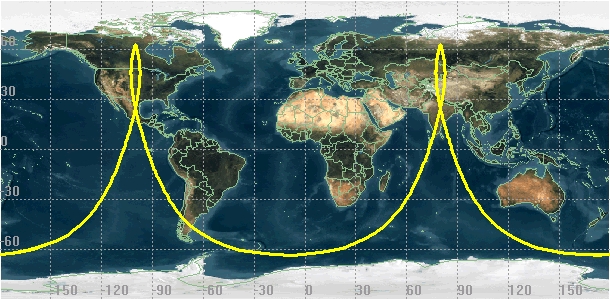Molniya orbit
Molniya orbit is a class of a highly elliptic orbit with inclination of 63.4° and orbital period of about 12 hours. A satellite placed in this orbit spends most of its time over a designated area of the earth, a phenomenon known as apogee dwell. Molniya orbits are named after a series of Soviet/Russian Molniya communications satellites that have been using this class of orbits since the mid 1960s. Molniya orbits are not limited to Earth orbits only as they can be computed for any celestial body for which secular variations in longitude of the ascending node and argument of perigee because of central body’s oblateness have dominant effects on bodies orbiting it.
Properties
For stationary apogees the orbital period must divide 24 hours evenly. A 12 hour orbital period gives two apogees (that is, when the satellite reaches apogee it is always over one of two spots on the earth) and two perigees; a six hour period would give 4 of each type.
A large inclination allows the apogee to be close to either the north or south pole (Russians or Canadians or Swedes would put it close to the north pole), where coverage for a geostationary satellite is poor or non-existent. In general, the oblateness of the earth perturbs the argument of perigee, so that even if the apogee started near the north pole, it would gradually move unless constantly corrected with "station keeping" thruster burns. To avoid this expenditure of fuel, the Molniya orbit uses an inclination of 63.4°, for which these perturbations are zero.
Use in communications
The Molniya orbit allows for 24h communications coverage of polar regions by a constellation of 3 satellites. The first satellite to use this orbit was Molniya 1-01 launched on August 23, 1965.
American satellites have also used Molniya orbits, including the Satellite Data System cluster.
Other uses
A Molniya orbit is not suitable for manned spacecraft as it crosses the high-energy Van Allen belt.
According to some sources, the Soviet Fractional Orbital Bombardment System functioned by mimicking a standard satellite travelling in a Molniya orbit. Classified American electronic intelligence satellites called Jumpseat and their successors called Trumpet are also reported to use Molniya orbits.
Derivation
In order to ensure that the position of the apogee is not severely affected by orbit perturbations, an inclination close to 63.4° degrees is chosen. This results in the argument of perigee remaining nearly constant for a long period of time.
The formula for the argument of perigee change per day is as follows:
The equation becomes zero for an inclination of 63.4 degrees.
Interesting Fact
The Molniya orbit originates from the Russian word for lightning. It is a fitting name, as the satellite passes close to the earth relatively quickly. The Russian "Molniya" satellite was the first to be sent into this orbit and earned the rights to the name.
References
- Orbital Mechanics by Robert A. Braeunig
- Molniya-1 spacecraft by Mark Wade of Encyclopedia Astronautica


